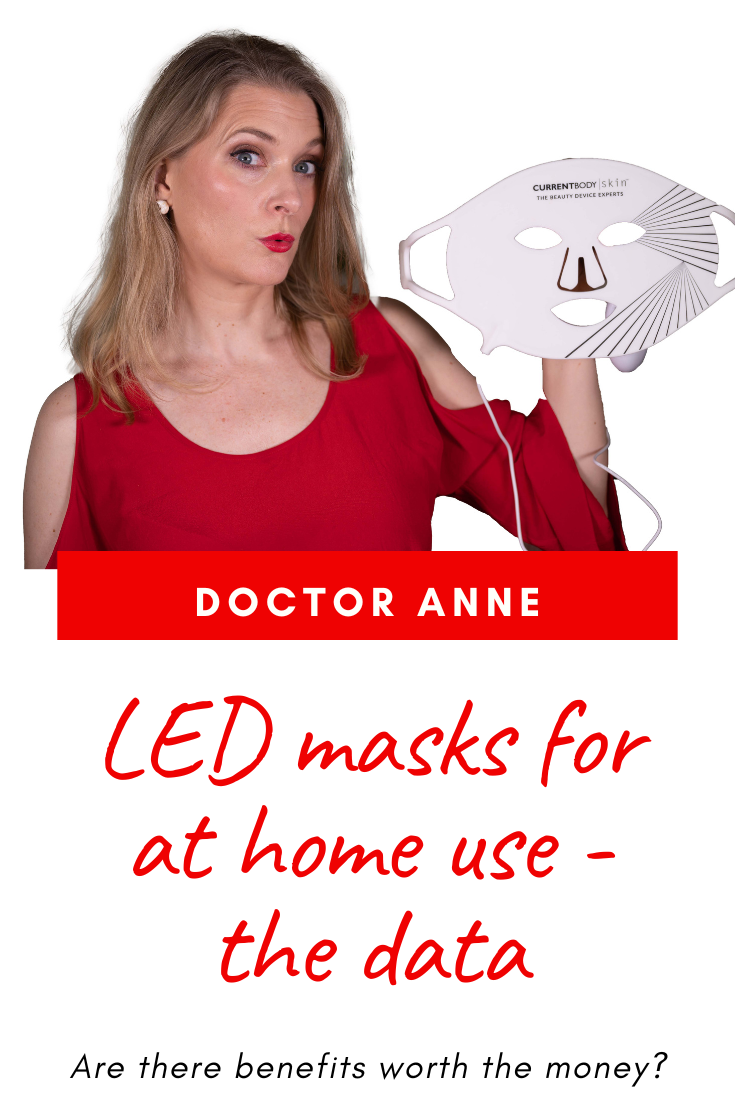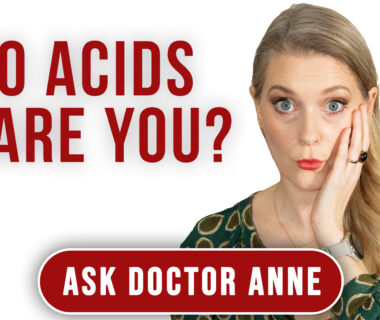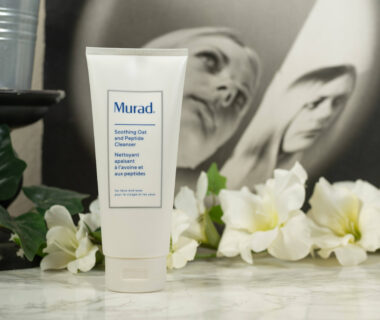ADVERTISEMENT INFO: PRODUCTS MENTIONED IN THIS POST ARE PR (GIFTED) AND LINKS USED ARE AFFILIATE LINKS. I RECEIVED NO MONEY TO WRITE THE BLOGPOST. PLEASE READ DISCLAIMER
The older I get, the more I look into devices to combat premature aging. After all, skincare can only do so much and I am not ready yet for something more invasive. (More info: Can skincare cure acne?)

Within the many things available, LED masks stood out to me, both because I know there have been studies done reporting some success – we will get to them later – and because they appeal to my lazy self as in: You don’t have to actually do anything other than put them on.
As always you guys were really helpful in coming up with a ton of questions, so let’s get into answering them.
Oh, and if you want, after today’s theoretical block, to learn how my first experience with a mask went, I will share my very personal results next Monday, so come back if you don’t want to miss that. (More info: LED therapy, my 8 week results – coming soon)
What does LED stand for?
LED stands for Light Emitting Diode and refers to the little “lamps” you see in the mask. These lamps aren’t your regular light bulb, but diodes or a semiconductor light source, meaning that when current flows through them, light gets emitted.
Each one of these diodes emits a different color of light or wavelength, which is determined by the energy required inside the semiconductor.
LED-devices are often called LLLT-devices as well, with LLLT standing for Low Level Light Therapy.
How does LED work?
When light is emitted, it can be described as an electromagnetic wave, and these electromagnetic waves are made from photons. Photons can be used to alter biological activity, meaning they can transfer energy to certain parts in the body – which parts depends on different factors, with the wavelength being the most important, as each tissue has a certain wavelength it is best affected by.
When the photons reach the right cells, they can energize the cells, stimulating them to repair, to increase their output or to better fight inflammation.
That might be a good thing and is used for photorejuvenation and hair growth, but it might also be a bad thing when it for example stimulates melanocytes to produce more melanin, leading to hyperpigmentation, or causes skin cancer in context with UV radiation – which is also light of a certain wavelength, just not from the spectrum of visible light.
(More info: The different types of hyperpigmentation explained)
What is the difference between the different wavelengths?
The wavelengths differ in the color of light they are perceived as and in the depth they penetrate tissue with, meaning the wavelength determines where in the tissue the light can go – yellow, green and orange are mostly absorbed by the melanocytes and don’t really do much deeper in the skin.
The ones most interesting for us when it comes to skincare are blue light, red light and near infrared light.
Blue light (400 – 495 nm) is used to kill off acne bacteria, so it is primarily used in devices that target pimples. Blue light is also the most likely to trigger hyperpigmentation, so be careful when you are prone to that, and can cause damage to the eye, so if you use blue light devices that aren’t handheld spot targeting devices, you should wear eye protection. The ideal wavelength for blue light seems to be 415 nm.
Red light (600 – 780 nm) and Near Infrared Light (780 – 1400 nm) are used for increased wound healing, stimulating collagen and elastin production and decreasing inflammation. The ideal wavelengths seem to be 633 nm for red light and 830 nm for near infrared light.
What do the studies tell us?
If we look at the data available, there seems to be a lot at first glance, but in order to determine if we get an answer to our question regarding the effects of LED masks for at home use, we will quickly see that there isn’t much telling us if they work or not.
The first part we need to exclude here are all the studies done in vitro, meaning on isolated cells, and on animals, as we know that they are great at creating a hypothesis, but not in providing us with answers for cells still part of the human body.
Once we have narrowed it down here, we need to look if the studies done on actual humans are comparable, meaning if they looked at the same endpoints and used the same means as in wavelength, irradiance and treatment time. And here is where the main problem occurs: out of the studies we have, not many are comparable, which is probably the explanation why they yield different results, ranging from very good to no effects at all on the many endpoints they looked at.
What the consensus, meaning the thing people will agree on, is, is that blue light at 415 nm seems to help reduce acne (the mechanism here is that Cutibacterium acne has porphyrin, a pigment, that is targeted best at 415 nm, so blue light with this wavelength will kill it off). As blue light does not affect inflammation though, it is beneficial to be combined with red light at 633 nm or near-infrared light at 830 nm to get antiinflammatory and wound healing effects and to counteract the risk for hyperpigmentation that seems to be highest with blue light and even higher when blue light with a different wavelength than 415 nm is used.
Both red and near-infrared light have shown promising results in what is referred to as skin rejuvenation, with red light at 633 nm stimulating collagen production and near infrared light at 830 nm being anti-inflammatory, speeding up wound healing and, not important in terms of skins appearance, but in other contexts, with pain reduction.
What is also common consensus is that mixing different wavelengths might actually reduce the positive effects, as they can hinder each other, and that only the three exact wavelengths mentioned did show the benefits, so straying from them could lead to no or even unwanted effects on the skin.
Wavelengths you can mix are: Blue and red, blue and infrared or red and infrared.
The most important thing to note though is that the majority of these studies were made in an in-office setting with in-office devices, which can have a much higher output than the ones you use at home, where the main concern is safety. A device for at home use needs to be safe even if you use it much longer than recommended, or much more frequent than the instructions tell you, so naturally the power can’t be as high as it would be when applied by a trained professional.
That doesn’t mean that at home devices are useless, it just means that you can’t transfer the data we have 1:1 to the products you can buy.
How can I tell if a mask is a good one and worth the money?
Now if you decide you want to buy a LED face mask for at home use, how do you find the best one? There are three things to look for: Wavelength, irradiance and comfort.
We talked about the wavelengths before, and the mask you purchase should offer exactly the ones mentioned as precisely as possible. A mask telling you it uses red light might have wavelengths from 600 to 780 nm, and you have no means of knowing how much – if any – of the lamps used will give you the 633 nm you are looking for. It also shouldn’t mix too many different ones, as they could hinder each other.
As for the irradiance, it shouldn’t be too low, or else you won’t get the desired effect without wearing the mask 24/7, but it also shouldn’t be too high, as too much might lead to tissue overheating or other unwanted effects. The desired irradiance seems to be between 40 and 150 mW/cm2, but you won’t find at home devices offering more than 50 mW/cm2 as here the risk for overheating increases. Most masks you can purchase are much lower. For the amount of LEDs used – that is another thing to look at, but less important than the irradiance – more light bulbs mean that your face get’s a more even coverage, but in the end they don’t tell you much about the power you get. In doubt, go for the better irradiance over the number of LEDs.
As for comfort, it is much more important than you might think at first. LED therapy is something you need to do regularly over a long period of time to see results, usually 8-12 weeks before you even start to see changes, and with better effects as time goes by. It is much easier to keep up with a mask that fits comfortably and doesn’t need to be worn every day for 30 minutes. I mean, I don’t know about you, but I am much more likely to do something three times a week for ten minutes than committing to it for a prolonged period of time every single day. Get a mask that fits your face and your lifestyle so you will actually use it. Otherwise it is just expensive clutter, no matter how good all the other stats are.
Examples of masks that meet the requirements
I personally have tried but one mask – my review will be up next Monday – and it is the Current Body Skin LED Light Therapy one. It has just red and near-infrared light at 633 and 830 nm, a total irradiance of 30 mW/cm2 and is recommended for use 3-5 times a week for ten minutes each. It obviously lacks the blue light, so isn’t geared at acne, but meets all the other requirements.
Three other ones that are similar in numbers are the Omnilux Contour one, the PRIORI Unveiled one and the Light Salon Boost Mask. There are several others as well that seem identical in stats, and I will link to a blog post I found recently by “Goals to get glowing” that has a detailed overview of 26 different masks along with some discount codes for you to use should you consider buying one.
The very popular Dr Dennis Gross SpectraLite FaceWare Pro you most likely have seen somewhere offers blue light at 415 nm alongside the red and near -infrared light, but also a few other wavelengths other than 633 and 830 nm, which I am not the biggest fan of as mentioned above. It has the highest irradiance though with between 50 – 61 mW/cm2, meaning you need to wear it for a short amount of time only.
Conclusion
Now this seems to be the conclusion I draw pretty often, but overall the evidence just isn’t there for me to recommend using a LED device to everyone. It is far more important to have your basics covered as in regular broad spectrum sunscreen, antioxidants and possibly a retinoid, and it is way too expensive to just buy it to see if it works.
For the amount of money you spend on the device, you could get several rounds of Botox or another intervention in-office that might deliver more reliable results. Even if you decide to invest in one, be it for skin rejuvenation or for acne, you need to be aware that it will only ever be an enhancement of what you are already doing, never a complete game changer.
(More info: Your comprehensive guide to retinoids)
If I hadn’t been sent one, I probably would have purchased one eventually, just out of curiosity, but I am in my mid-40s and in the comfortable position to be able to spend that amount on stuff without it hurting me too much if it ends up not working.
But I did get sent one, and without taking too much away from the post coming next Monday: I love mine. As an on top extra with the added bonus of scaring the kids and making my husband laugh, but as an extra that, at my age, is an investment well worth it. That is completely anecdotal evidence though, and probably with the bias that I WANT to see results now that I sit there every other night looking like an extra from Friday 13th, only in glowy.

Sources:
LED Mask Comparison and a Deep Dive into Low Level Light Therapy (LLLT) – Goals To Get Glowing. (n.d.). Retrieved May 8, 2022, from https://goalstogetglowing.com/2021/01/17/deep-dive-into-led-masks-and-low-level-light-therapy-lllt/
Anti-inflammatory properties of narrow-band blue light – PubMed. (n.d.). Retrieved May 8, 2022, from https://pubmed.ncbi.nlm.nih.gov/16865864/
Gupta, A., Dai, T., & Hamblin, M. R. (2014). Effect of red and near-infrared wavelengths on low-level laser (light) therapy-induced healing of partial-thickness dermal abrasion in mice. Lasers in Medical Science, 29(1), 257–265. https://doi.org/10.1007/s10103-013-1319-0
Lee, S. Y., Park, K. H., Choi, J. W., Kwon, J. K., Lee, D. R., Shin, M. S., Lee, J. S., You, C. E., & Park, M. Y. (2007). A prospective, randomized, placebo-controlled, double-blinded, and split-face clinical study on LED phototherapy for skin rejuvenation: clinical, profilometric, histologic, ultrastructural, and biochemical evaluations and comparison of three different treatment settings. Journal of Photochemistry and Photobiology. B, Biology, 88(1), 51–67. https://doi.org/10.1016/J.JPHOTOBIOL.2007.04.008
Russell, B. A., Kellett, N., & Reilly, L. R. (2005). A study to determine the efficacy of combination LED light therapy (633 nm and 830 nm) in facial skin rejuvenation. Journal of Cosmetic and Laser Therapy : Official Publication of the European Society for Laser Dermatology, 7(3–4), 196–200. https://doi.org/10.1080/14764170500370059
Van Tran, V., Chae, M., Moon, J. Y., & Lee, Y. C. (2021). Light emitting diodes technology-based photobiomodulation therapy (PBMT) for dermatology and aesthetics: Recent applications, challenges, and perspectives. Optics & Laser Technology, 135, 106698. https://doi.org/10.1016/J.OPTLASTEC.2020.106698
Wunsch, A., & Matuschka, K. (2014). A controlled trial to determine the efficacy of red and near-infrared light treatment in patient satisfaction, reduction of fine lines, wrinkles, skin roughness, and intradermal collagen density increase. Photomedicine and Laser Surgery, 32(2), 93–100. https://doi.org/10.1089/PHO.2013.3616
Shop the post
Use the code DRANNECB for 50$ off on the Current Body Skin website (works both on the US and the German website)
Don’t forget to check out the Discount Code Page on top if you want to save some money on your next skincare purchase.
If you want to get a vote in the next Ask Doctor Anne Topic, Ingredient Spotlight or product I review, don’t forget you can head over to my Patreon account to get more involved!


